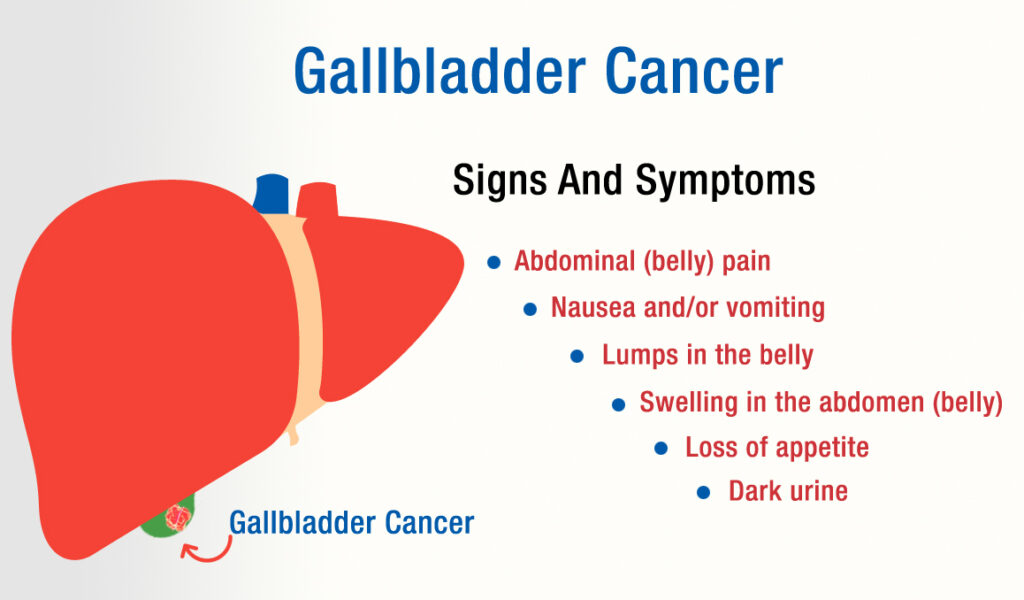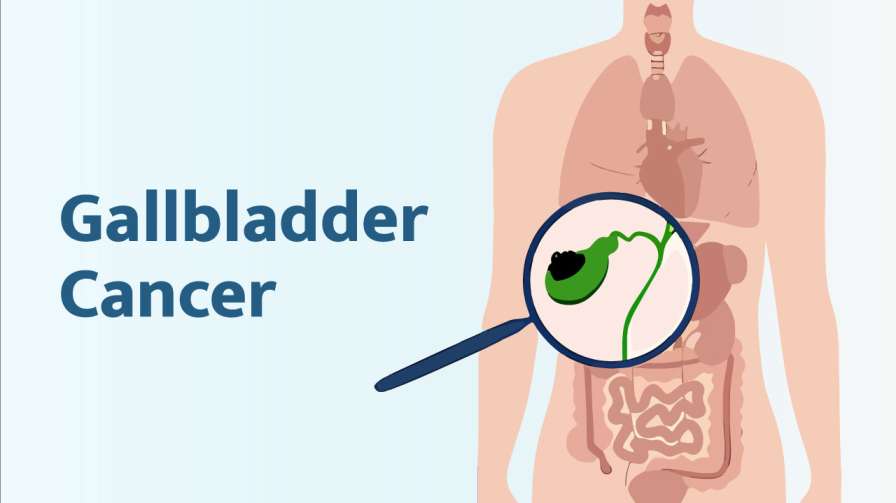Gallbladder Cancer – Causes, Symptoms, Diagnosis & Treatment
What Is Gallbladder Cancer?
The gallbladder is a small, pear-shaped organ located beneath the liver on the right side of the abdomen. It stores bile, a digestive fluid that helps break down fats. Gallbladder Cancer develops when abnormal cells grow uncontrollably in the lining of the gallbladder. Although it is considered rare, it is often diagnosed at an advanced stage because early symptoms are usually unclear or absent.

Signs & Symptoms of Gallbladder Cancer
Gallbladder Cancer may not cause noticeable symptoms in its early stages. As the disease progresses, the following signs can appear:
- Jaundice (yellowing of the skin and eyes)
- Abdominal pain, especially in the upper right side
- Bloating or swelling in the abdomen
- Nausea and vomiting
- Loss of appetite
- Unexplained weight loss
- Fever


Risk Factors
Several factors can increase the risk of developing Gallbladder Cancer:
- Gallstones (most common risk factor)
- Chronic gallbladder inflammation or infections
- Gallbladder polyps
- Age (more common in people over 60)
- Family history of gallbladder or bile duct cancer
- Female gender (gallbladder cancer is slightly more common in women)
- Obesity
- Exposure to certain industrial chemicals
Diagnosis & Staging
Diagnosing Gallbladder Cancer typically involves a combination of tests and scans:
- Ultrasound to detect gallstones or gallbladder abnormalities
- CT or MRI scans to see detailed images of the gallbladder and surrounding organs
- Blood tests to check liver function
- Biopsy to confirm cancer cells
- ERCP (Endoscopic Retrograde Cholangiopancreatography) for detailed imaging and tissue sampling
Staging is done to determine how far the cancer has spread:
- Stage I: Limited to the gallbladder lining
- Stage II: Spread into the gallbladder muscle wall
- Stage III: Spread to nearby organs like the liver or lymph nodes
- Stage IV: Advanced spread to distant organs
Treatment Options
Treatment for Gallbladder Cancer depends on its stage, spread, and patient health:
- Surgery – If detected early, removal of the gallbladder (cholecystectomy) may cure the cancer. In advanced cases, surgery may involve removing parts of the liver and bile ducts.
- Chemotherapy – Helps destroy cancer cells or shrink tumours before surgery.
- Radiation Therapy – Used to control tumour growth and relieve symptoms.
- Targeted Therapy & Immunotherapy – Advanced treatments that attack specific cancer mutations or boost the immune system.
- Palliative Care – Focused on symptom relief and improving quality of life for advanced stages.
Prevention & Early Detection
While there is no guaranteed way to prevent Gallbladder Cancer, steps can reduce risk:
FAQs About Gallbladder Cancer
Yes, Gallbladder Cancer can be curable if it is diagnosed at an early stage and surgically removed. However, because Gallbladder Cancer is often detected late, treatment becomes more complex and challenging in advanced cases.
In many cases, Gallbladder Cancer does not show clear symptoms in its early stages. When symptoms do appear, they may include abdominal pain, jaundice (yellowing of eyes and skin), bloating, nausea, or unexplained weight loss.
The risk of Gallbladder Cancer is higher in people with gallstones, chronic gallbladder inflammation or infections, gallbladder polyps, older adults, women, and individuals with a family history of Gallbladder Cancer.
Doctors may use multiple tests to diagnose Gallbladder Cancer, including ultrasound, CT scans, MRI, blood tests for liver function, ERCP, and biopsy to confirm the presence of cancer cells.
The survival rate of Gallbladder Cancer depends greatly on the stage at which it is diagnosed. Early-stage Gallbladder Cancer offers better treatment outcomes, while advanced-stage cancer has a less favourable prognosis.


